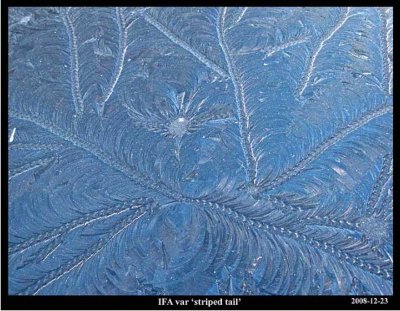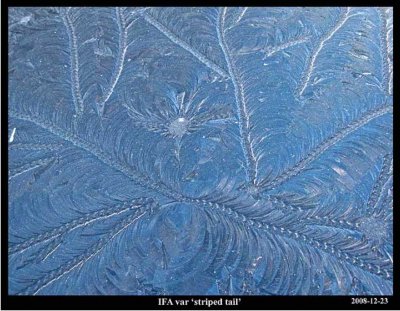| « Avalanches, Part 1: Snow Hardening | Snow Crystal Variety and the Bentley Length Scale in Clouds » |
Ice Classification System of Bentley
[This is the fifth in the series of re-posted articles, from 2010.]
The most comprehensive study of frost and small ice formations was published way back in 1907 by Wilson A. Bentley. His article was split into five successive issues of the Monthly Weather Review (1) with the title “Studies of Frost and Ice Crystals”. In the article, Bentley details his classification system for frost and some related ice forms, and gives examples of nearly every type – in total 274 examples in photographs. His classification system is ingenious, the first (and probably only) classification system for frost and ice on surfaces. Unfortunately for such an extensive, pioneering article, few books or articles reference it.
His system gave each crystal form a 3-letter label. The first letter gave the type of frost or place of deposition. He designated five such types: window-frost (i.e., film-frost) (W), hoarfrost (H), window-ice (I), massive ice (M), and hailstones (S). Considering the first letter of each type, we could call this the WHIMS system. Briefly, “W” includes curvy frost that forms within a relatively thick condensation film on surfaces (in his studies, windowpanes), “H” includes the long, densely packed, straight needles sticking out of exposed surfaces on cold mornings outside, “I” is ice that forms on relatively dry surfaces, “M” is ice that forms in “thick” bodies of water like puddles and lakes, and “S” is hailstones.
The second letter designated the characteristic form of the crystal. In all, he designated 20 kinds, but some letters were used for several forms. For example, although “B” would designate only a branch-like form, “C” could designate either column-like or coral-like forms. So, presumably, “WC” could mean either window-frost crystals in a column form or window-frost crystals in a coral form. “T” is similar in that it stands for either tabular or tooth-like forms. However, of the crystal types classified by Bentley, there was little confusion because W-types had only one C-characteristic, and that was WCG, or window-frost resembling columns. The other C-characteristic occurred only in massive ice, specifically MCF, massive ice resembling coral. Even if there had been two WC types, they would be distinguished by their third letter, the letter that designated how common the form appeared (at least to him). Specifically, an “A” would indicate that this is the most common form, a “B” would be less common. In principle, this could continue until “Z”, though the ones he classified only went as far as “K”. For example, in the most-used letter “F”, we distinguish two WF forms because one is WFC, a filament-like form that is relatively common, and WFJ, a fiber-like form that was rare. The other two Fs refer to filament-like and flower-like forms.
The WHIMS system is extensive, but it doesn’t include frost of two origins. In particular, film-frost on non-glass surfaces is common, but very hard to see unless some white hoar crystals grow up and off the surface. In addition to revealing the pattern of film-frost, the hoar that grows up off the frozen film can have it’s own characteristics. This case is hard to fit with Bentley’s classification, yet I see it far more often than pure film-frost. He was aware of this case, as he mentions such dual types in his discussion of the stages of window-ice formation; specifically, he divides their growth into four stages with the fourth stage being hoarfrost. This difficulty is related to another shortcoming: it is not clear what exact purpose he meant for the second letter. He wrote that this letter represents the characteristic form, and for hoar, he clearly refers to characteristics of the crystals, labeling them either columnar (C) or tabular (T). But with window-frost and window-ice, it is often hard to distinguish the individual crystals, and the characteristic pattern one sees are partly, sometimes wholly, a consequence of the positions of the crystals, not their individual shapes.
Judging by the number of examples, the type he enjoyed the most was type IFA, featherform window-ice crystals. As this type includes a wide range of patterns, it’s too bad he didn’t create IFB, C, D, etc. to distinguish some of the patterns. These patterns include my favorite formation, which I nicknamed “striped tail frost”. He called them “the most strange and rare specimens of beautiful feather-form window-ice crystals”. He likened their pattern to an evergreen vine, and gave some description of the special conditions that produced them. For the images he showed, he explained a mechanism in which the windowpane cooled from the right edge to the left edge, and because of sunshine and “zero weather”, the temperature change was large. Above I show a similar frost formation, except the frost is on the roof of a black car, not a windowpane. (The best versions of this type though seem to happen exclusively on glass.)
A close up of three bands of the tail, shown above suggests that the pattern consists of many thin, slightly curving ice blades. But the magnification from my compact camera does not reveal a clear reason for the alternating dark and light bands.
In other formations, I’ve noticed that the whiter parts are hoar crystals that either stick up much higher than other regions or are denser (2). Bentley offered the former reason for the white bands. But it almost appears that the white parts are where new blades start, to fill in the gap left by two existing blades that diverge. If this is the case, then the white bands are places where the hoar is denser. If I see this pattern again, I’ll try to get a clearer close-up image to help determine the origin of the white bands.
Bentley’s article should be read by everyone who wants to learn about frost. It is easy to read and contains a lot of careful observations, including high magnifications of frost features, and many good ideas. For example, Bentley argued that all columnar hoarfrost probably starts after small condensation droplets on a surface freezes. After observing a lot of hoarfrost over the past few years, I came to the same idea (though I suspect it applies to all hoar, not just columnar).
Unfortunately, another one of his statements did not stand the test of time very well:
"It is a delight to know that our windowpanes will for all time be glorified and beautified in winter by these exquisite creations of window ice, and by those other elegant crystal structures that are next of kin to them, the window-frost crystals."
Even though few windowpanes these days get cold enough to frost, many outdoor surfaces do, and these show the same patterns Bentley classified as well as some new patterns. And although his WHIMS system has seen little-to-no use, it may have inspired a similar classification system that cloud scientists now use for snow crystals. The snow system, begun by Ukichiro Nakaya, a scientist inspired by Bentley, wasn’t published until nearly 50 years had passed (3). Twelve years later, Nakaya’s system was extended to the Magono and Lee version used today (4). But Bentley’s system is open-ended; that is, one can keep adding rarer and rarer forms to it. So in principle, his system never needs to be extended (5). It seems once again that Bentley was out ahead of the pack.
--JN
References and notes
1. This article is freely available on the internet. The five parts are at the links below. All 274 images are at link e).
a) http://docs.lib.noaa.gov/rescue/mwr/035/mwr-035-08-0348.pdf
b) http://docs.lib.noaa.gov/rescue/mwr/035/mwr-035-09-0397b.pdf
c) http://docs.lib.noaa.gov/rescue/mwr/035/mwr-035-10-0439.pdf
d) http://docs.lib.noaa.gov/rescue/mwr/035/mwr-035-11-0512b.pdf
e) http://docs.lib.noaa.gov/rescue/mwr/035/mwr-035-12-0584.pdf
2. See some of the images elsewhere on this blog.
3. Nakaya, U. (1954) Snow Crystals: Natural and Artificial (Harvard University Press)
4. Magono, C. and Lee, C. (1966) Meteorological Classification of Natural Snow Crystals. J. Faculty of Science, Hokkaido University. Series 7, Geophysics 2(4) pp. 321- 335. Also, see this classification in Edward R. Chapelle’s nice little book “A Field Guide to Snow Crystals”. It is probably also in Kenneth Libbrecht’s “Field Guide to Snowflakes”.
Note added: as reported on this blog, a newer classification came out three years later, in 2013. It is the KKHY and has 121 forms.
5. But it could be revised. On a somewhat whimsical note, I suggest the BEDFISH revision on my 2010 Jan. 31st posting at reference (2).


